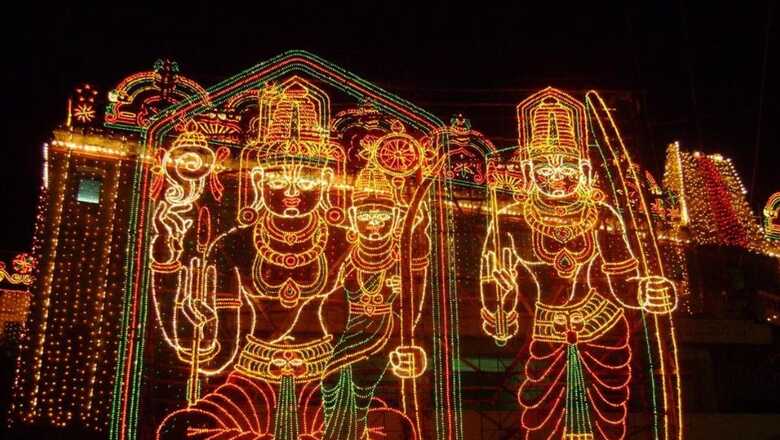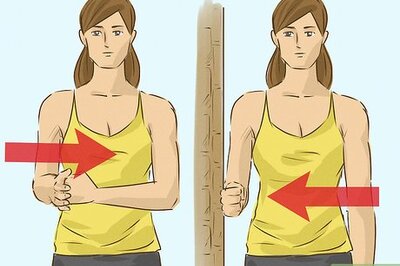
views
Telangana Chief Minister Revanth Reddy, while replying to a reporter’s question on whether he would go for the ‘Pran Pratishtha’ ceremony at Ayodhya’s Ram Temple, said while he intends to visit the temple later, he does not find any difference between it and the Bhadrachalam temple in Telangana.
Reddy added that he is a regular visitor to the Sita Ramachandraswamy temple, which is located on the banks of river Godavari, at Bhadrachalam in Bhadradri Kothagudem district. It is also referred to as Dakshina Ayodhya.
As the devout in the country rejoice about the new temple in Uttar Pradesh, the temple in Bhadradri is an interesting mention as it is one of the few temples in which the main deity has four hands.
The icon worshipped there is Vaikuntha Rama, a form Lord Vishnu took to fulfill a promise made to a devotee. It is said that in his hurry to appear as Ram, Lord Vishnu forgot that the former was a mortal and he retained his four arms. The deity features wife Sita sitting on the lap of Ram and brother Lakshman standing beside him.
Story behind the temple
The Bhadrachalam temple is unique not only because of the four-armed deity, but also the stories associated with it.
It is said that a stone turned into a human being named Bhadra due to Lord Ram’s grace. He was the son of Mount Meru and Menaka. In order to convey his gratitude to his Lord, Bhadra started meditating on the banks of Godavari. Around the same time, Ram, Sita and Lakshman were living in Dandaka forest after they were sent on a 14-year exile. After years of Tapasya, Bhadra did manage to spot his Lord, but Ram could not halt to meet him as he was looking for Sita who had been abducted by Ravana. However, he promised that he would later come and bless Bhadra. As he engaged in an epic battle with Ravana, Ram was unable to honour the promise made to his devotee.
Years later, Lord Vishnu remembered the promise and made an appearance in front of Bhadra. He also brought along Sita and Lakshman with him. Bhadra’s joy knew no bounds to see the unique avatar of Lord Ram. He had a conch in one hand, Sudarshan Chakra in another, and bow and arrow in the lower hands. Hence, the place where the Lord appeared was christened Bhadrachalam or Bhadradri.
Another story says that a devotee of Lord Ram, Pokala Dhammakka, had a dream that a statue of God was hidden in the forest. After intense search, she found this icon of Lord Ram buried in an anthill. She then established it as a deity with the help of villagers.
Bhadrachala Ramadasu
The temple was built in the 17th century due to the efforts of Bhakta Ramadasu. He is a legendary figure in the Telugu-speaking states and numerous movies have been made on his life. His real name was Kancherla Gopanna and he was a tehsildar under the reign of the last Sultan of Golconda, Abul Hasan Qutb Shah.
He was known for his Ram bhakti and is one of the most renowned ‘vaggeyakaras’ in Telugu. As part of his job, he had to collect taxes from villagers. When he came across the Ram deity in Bhadrachalam, he expressed a desire to build a temple there. He asked villagers for contributions, and when the money fell short, he used the revenue he had collected for the government. Though the temple was built, he was sent to prison for 12 years for fraud. Even in confinement, he composed hymns in praise of Lord Ram.
It is said that two young men, who were none but Rama and Lakshmana in disguise, paid the Sultan gold coins to release Ramadasu.
Politics over temple
When Andhra Pradesh was bifurcated, Telangana and residuary AP had fought to include the temple in their own territories. The former chief minister, K Chandrasekhar Rao, was criticised time and again for not personally offering pattu vastralu (silk clothes) and Mutyala Talambralu (pearls) to the temple during the celestial wedding of Lord Rama and Sita.
This is an age-old tradition that is being followed from the 17th century in which the reigning ruler brings these offerings for the wedding. During his election pitch in the last assembly elections, Union home minister Amit Shah had said that if BJP came to power, the chief minister would resume this tradition.

















Comments
0 comment